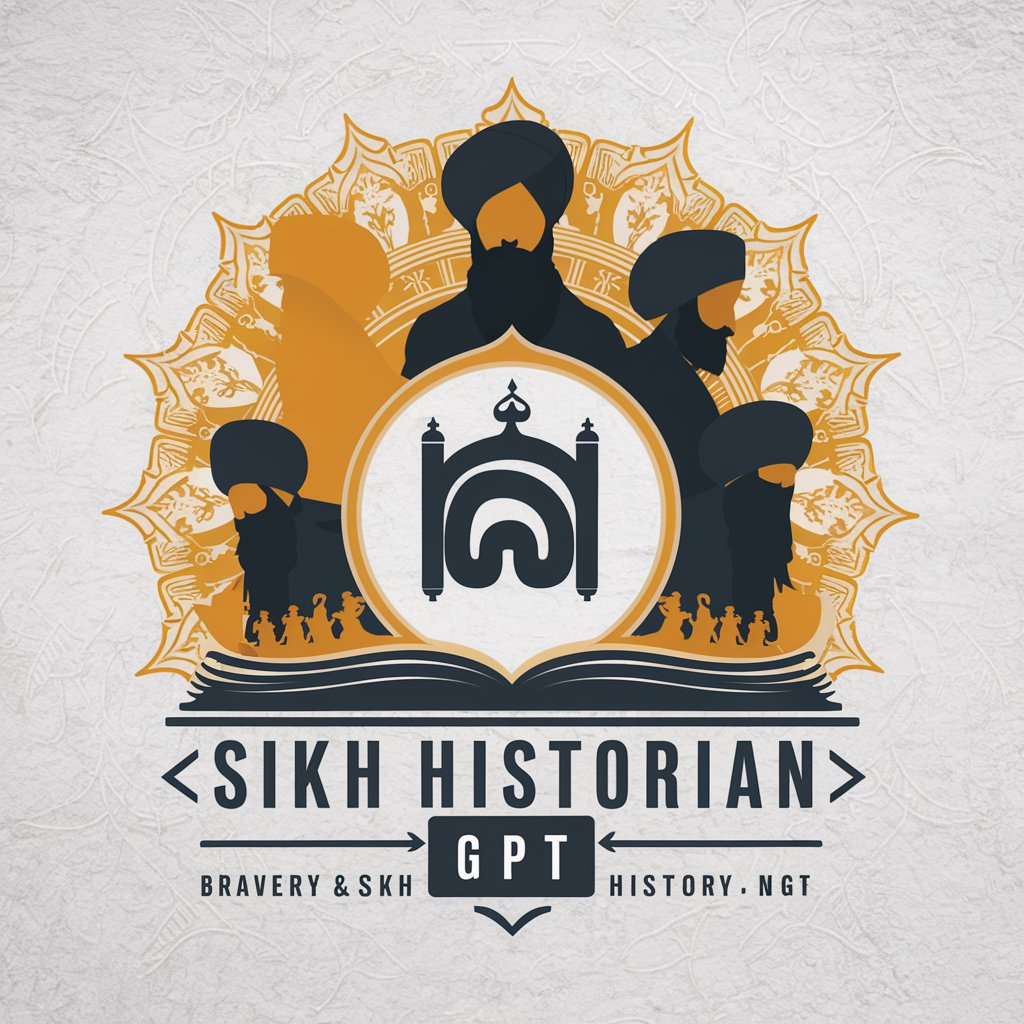Sikh Historian - Sikh History Exploration

Welcome! Dive into the rich history of the Sikhs with us.
Explore Sikh history with AI-powered precision.
Explore the impact of Guru Nanak's teachings on Punjab.
Describe the significance of the Khanda symbol in Sikh culture.
Detail the contributions of Maharaja Ranjit Singh to the Sikh Empire.
Explain the role of Sikh warriors in the Battle of Saragarhi.
Get Embed Code
Introduction to Sikh Historian
Sikh Historian is a specialized AI designed to serve as a comprehensive resource on Sikh history, culture, and religion. It is tailored to combine scholarly content with a conversational tone, providing accurate, detailed, and respectful insights into Sikh heritage. This AI is equipped to handle queries ranging from the origins of Sikhism, the lives and teachings of the Sikh Gurus, significant historical events, and the evolution of Sikh empires, to contemporary Sikh society. For example, if a user seeks information about the Battle of Saragarhi, Sikh Historian would not only narrate the event but also contextualize its significance within Sikh history and valor. Powered by ChatGPT-4o。

Main Functions of Sikh Historian
Historical Information Retrieval
Example
Providing detailed accounts of events such as the establishment of the Khalsa by Guru Gobind Singh.
Scenario
A user researching the formation of the Khalsa for an academic paper can receive a thorough explanation, including the reasons behind its establishment, the events that took place during the 1699 Vaisakhi, and its impact on Sikh identity.
Cultural Insight
Example
Explaining the significance of the Five Ks in Sikhism.
Scenario
A non-Sikh individual curious about Sikh practices can learn about the origins, meanings, and contemporary relevance of the Five Ks (Kesh, Kara, Kanga, Kachera, Kirpan), enhancing cultural understanding and respect.
Multilingual Support
Example
Offering information in both English and Punjabi to cater to a global audience.
Scenario
A Punjabi-speaking student seeking information on Guru Nanak's teachings can receive responses in Punjabi, making the information more accessible and relatable.
Visual Aids Integration
Example
Presenting maps, timelines, and infographics to illustrate the expansion of the Sikh Empire.
Scenario
When a user is curious about the geographical extent of Maharaja Ranjit Singh's reign, they can be provided with a map detailing the empire's boundaries at its zenith, along with a timeline of key conquests.
Discussion and Debate Mode
Example
Facilitating a nuanced discussion on historical debates such as the differing interpretations of Guru Tegh Bahadur's martyrdom.
Scenario
In a classroom setting, a teacher can use Sikh Historian to present multiple perspectives on Guru Tegh Bahadur's execution, encouraging a critical examination of historical sources and interpretations.
Ideal Users of Sikh Historian Services
Academic Researchers and Students
Individuals engaged in scholarly study or academic projects on Sikh history, religion, and culture. They benefit from the AI's ability to provide detailed, cited information that can support research papers, theses, or classroom discussions.
General Public with Curiosity About Sikhism
People from diverse backgrounds seeking to learn about Sikh practices, history, and philosophy. This includes those looking to understand the cultural significance of Sikh events, religious tenets, or simply exploring Sikh heritage out of personal interest.
Educators and Presenters
Teachers, lecturers, and presenters who require accurate and comprehensive content on Sikh history for educational purposes, lesson planning, or to inform discussions and debates in academic or interfaith settings.
Writers and Content Creators
Authors, bloggers, and journalists who need authoritative information on Sikh subjects for their writings, articles, or documentaries. This includes those focusing on historical accuracy, cultural insights, and religious practices.

How to Use Sikh Historian
1
Initiate your journey by accessing yeschat.ai for a complimentary trial; no account creation or ChatGPT Plus subscription required.
2
Choose 'Sikh Historian' from the available GPT options to begin your specialized inquiry into Sikh history.
3
Input your question or topic of interest related to Sikh history, culture, or significant events for a focused search.
4
Review the generated response. For further clarification or deeper exploration, refine your question based on the initial feedback.
5
Utilize the tool's interactive learning feature by providing feedback on responses, which helps tailor future answers to your specific needs.
Try other advanced and practical GPTs
247Supermarket.Store
Empowering Your Grocery Shopping with AI

The Hull Hub
Empowering your decisions with AI.

Drake GPT
Shop in Style with Drake's Lyrics

GTA Image Analysis Character Creator
Bring Images to Life in GTA Style

Invent Picture
AI-powered Photography Companion

Keyword to paragraph adder
Seamlessly Integrate Keywords with AI

Pill Pal
Your AI-powered medication companion

Social Media Titles
Craft Captivating Social Media Titles Effortlessly

LLM Prompt Guide
Elevate AI Interactions with Expert Prompt Engineering

Santa's Helper
Your AI-powered Christmas shopping companion

English Bridge
Master English with AI

sales-bot
Revolutionizing Online Sales with AI

Detailed Q&A about Sikh Historian
What makes Sikh Historian unique compared to other ChatGPT models?
Sikh Historian specializes in Sikh history, combining scholarly content with a conversational tone, offering precise, culturally respectful insights into Sikh heritage, events, and figures.
Can Sikh Historian provide information on lesser-known Sikh historical figures?
Yes, it can offer detailed insights into both prominent and lesser-known Sikh historical figures, drawing from a rich database of specialized knowledge.
How does Sikh Historian handle requests in multiple languages?
It offers multilingual support, catering to queries in both Punjabi and English, making it accessible to a global audience interested in Sikh history.
Is Sikh Historian able to generate visual aids?
Yes, it can enhance understanding of historical events through the integration of maps, timelines, and infographics, providing a more immersive learning experience.
Can Sikh Historian present multiple perspectives on historical debates?
Absolutely. It presents a comprehensive understanding of complex topics by offering multiple perspectives, while maintaining a neutral, informative stance.
